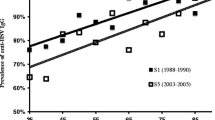Abstract
Herpes simplex virus types-1 (HSV-1) and Varicella-zoster virus (VZV) are herpes viruses that share many characteristics. However, HSV-1 spreads by close contact while VZV spreads mainly by the airborne route. In this study we compared the dynamics and correlates of transmission of these viruses in the same population. In 2000–2001, 1555 sera from an age-stratified general population sample were tested using commercial ELISA kits to measure type-specific HSV-1 and varicella IgG antibodies. The VZV seroprevalence increased rapidly with age reaching 50% seropositivity by the age of 3 years, while HSV-1 reached 50% seropositivity at the age of 14 years. The highest VZV force of infection was in the 3.5–5.5-year age group followed by the 5.5–10.5 years age group, while for HSV-1 the age specific force of infection was substantially lower and stable over the various age groups. Multivariate analysis revealed that HSV-1 seroprevalence was significantly, independently associated with age, country of birth, country of origin, ethnicity, socio-economic status and VZV sero-status. Only age, country of origin and HSV-1 sero-status were found to be associated with VZV seropositivity. In developed countries such as Israel the transmission of VZV is much quicker and less dependent on socioeconomic status as compared with HSV-1.


Similar content being viewed by others
References
Marculescu R, Richter L, Rappersberger K. Infections with herpes simplex and varicella-zoster viruses during pregnancy. Hautarzt 2006;57:207–16.
Malkin JE. Natural history of HSV1 and HSV2 transmission modes and epidemiology consequences of HSV infection on HIV infection. Prevention Ann Dermatol Venereol 2002;129:571–6.
Wharton M. The epidemiology of varicella-zoster virus infections. Infect Dis Clin North Am 1996;10:571–81.
Hope Simpson RE. Infectiousness of communicable diseases in the household (measles, chickenpox and mumps). Lancet 1952;2:549–54.
Ross AH. Modification of chickenpox in family contacts by administration of gamma globulin. N Engl J Med 1962;267:369–76.
Asano Y, Nakayama H, Yazaki T, Kato R, Hirose S. Protection against varicella in household contacts by immediate inoculation with live varicella vaccine. Pediatrics 1977;59:3–7.
Arbeter AM, Starr SE, Plotkin SA. Varicella vaccine studies in healthy children. Pediatrics 1986;78:748–56.
Stanberry LR, Rosenthal SL, Mills L, Succop PA, Biro FM. Longitudinal risk of herpes simplex virus (HSV) type 1, HSV type 2, and cytomegalovirus Infections among young adolescent girls. Clin Infect Dis 2004;39:1433–8.
Venkitaraman AR, Seigneurin JM, Lenoir GM, John TJ. Infections due to the human herpesviruses in southern India: a seroepidemiological survey. Int J Epidemiol 1986;15:561–6.
Kubo T, Rai SK, Nakanishi M, Yamano T. Seroepidemiological study of herpes viruses in Nepal. Southeast Asian J Trop Med Public Health 1991;22:323–5.
Stanberry LR, Rosenthal SL. The epidemiology of herpes simplex virus infections in adolescents. Herpes 1999;6:12–5.
Mossong J, Putz L, Schnider F. Seroepidemiology of varicella zoster virus in Luxembourg. Epidemiol Infect 2004;132:1121–7.
Thiry N, Beutels P, Shkedy Z, et al. The seroepidemiology of primary varicella-zoster virus infection in Flanders (Belgium). Eur J Pediatr 2002;161:588–93.
Davidovici B, Green M, Marouni MJ, Bassal R, Pimenta JM, Cohen D. Seroprevalence of herpes simplex virus 1 and 2 and correlates of infection in Israel. J Infect 2006;52:367–73.
Cohen D, Davidovici B, Smetana Z, Balicer RD, Mendelson E, Green MS. Seroepidemiology of Varicella zoster in Israel prior to the large scale use of the Varicella vaccine. Infection 2006;34:208–13.
Ashley RL. Performance and use of HSV type-specific serology test kits. Herpes 2002;9:38–45.
Grenfell BT, Anderson RM. The estimation of age-related rates of infection fromcase notifications and serological data. J Hyg (Lond) 1985;95:419–36.
Griffiths DA. A catalytic model of infection for measles. Appl Statist 1974;23:330–339.
Gershon AA, Raker R, Steinberg S, Topf-Olstein B, Drusin LM. Antibody to Varicella-Zoster virus in parturient women and their offspring during the first year of life. Pediatrics 1976;58:692–6.
2001. Sao I: Statistical abstracts of Israel 2001. Central Bureau of Statistics.Jerusalem: Hemel Press Ltd, 2001.
Vyse AJ, Gay NJ, Slomka MJ, Gopal R, Gibbs T, Morgan-Capner P, et al. The burden of infection with HSV1 and HSV2 in England and Wales: implications for the changing epidemiology of genital herpes. Sex Transm Infect 2000;76:183–7.
Nahmias AJ, Lee FK, Beckman-Nahmias S. Sero-epidemiological and sociological patterns of herpes simplex virus infection in the world. Scand J Infect Dis 1990;69:19–36.
Asano Y, Yoshikawa T, Ihira M, Furukawa H, Suzuki K, Suga S. Spread of Varicella-Zoster Virus DNA to family Members and Environments From Siblings With Varicella in a Household. Pediatrics 1999;103:e61.
Sawyer MH, Chamberlin CJ, Wu YN, Aintablian N, Wallace MR. Detection of varicella-zoster virus DNA in air samples from hospital rooms. J Infect Dis 1994;169:91–9.
Aarnisalo J, Ilonen J, Vainionpaa R, Volanen I, Kaitosaari T, Simell O. Development of antibodies against cytomegalovirus, varicella-zoster virus and herpes simplex virus in Finland during the first eight years of life: a prospective study. Scand J Infect Dis 2003;35:750–3.
Liyanage N, Fernando S, Malavige GN, et al. Seroprevalence of varicella zoster virus infections in Colombo District, Sri Lanka. Indian J Med Sci 2007;61:128–34.
Author information
Authors and Affiliations
Corresponding author
Electronic supplementary material
Below is the link to the electronic supplementary material.
Rights and permissions
About this article
Cite this article
Davidovici, B.B., Balicer, R.D., Klement, E. et al. Comparison of the dynamics and correlates of transmission of Herpes Simplex Virus-1 (HSV-1) and Varicella-Zoster Virus (VZV) in a sample of the Israeli population. Eur J Epidemiol 22, 641–646 (2007). https://doi.org/10.1007/s10654-007-9169-3
Received:
Accepted:
Published:
Issue Date:
DOI: https://doi.org/10.1007/s10654-007-9169-3




